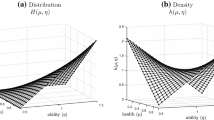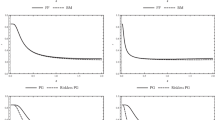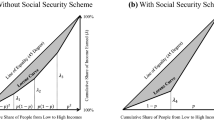Abstract
How well does social security jointly insure lifetime earnings risk and longevity risk? We show that the answer to this fundamental question depends critically on the nature of economic mobility across generations. To show this result, we compare two economies. In our first economy, inheritances are uncorrelated with wage earnings, implying that an individual’s earnings are unrelated to the wages and asset holdings of their predecessors. In our second economy, there is no such economic mobility; instead, low-wage earners are stuck receiving small inheritances from their low-wage ancestral line, while high-wage earners enjoy large inheritances from their high-wage ancestral line. We make these comparisons in a variety of settings including both fixed and endogenous factor prices. Social security causes large welfare losses in the first economy but can generate large welfare gains in the second economy. Given the apparent limits to economic mobility in the USA, the welfare gains from collective risk sharing through social security are potentially large.






Similar content being viewed by others
Notes
Although longevity risk can be insured using annuities, participation is low in private annuity markets and the market is characterized by asymmetric information and adverse selection [see Pashchenko (2013) for a discussion]. Similarly, there is no insurance market to protect against low-wage earnings over the life cycle.
Hosseini (2015) studies the welfare effects on mandatory annuitization through social security in a model where private annuity markets do exist but suffer from adverse selection problems. We abstract from the adverse selection problem and instead assume annuity markets are closed and focus our attention on the issue of economic mobility.
A number of studies examine the degree to which differential mortality by wage type offsets the level of redistribution that is otherwise implied by the progressive benefit earning rule (Coronado et al., 1999, 2002, 2011; Bishnu et al., 2019; Liebman, 2002; Goda et al., 2011; Gustman & Steinmeier, 2001), and a number of papers consider how this fact affects the desirability of different reform options (Pestieau & Racionero, 2016; Bommier et al., 2011; Sheshinski & Caliendo, 2020). We abstract from differential mortality considerations and focus directly on the role of intergenerational economic mobility in the study of risk sharing through social security.
One implication of our analysis is that optimal reform policies would preserve the current benefit levels. A vast literature explores changes in Social Security taxes and benefits in response to changing demographics such as Coronado et al. (1999, 2002), De Nardi et al. (1999), Diamond and Orszag (2005), Bommier et al. (2011), İmrohoroğlu and Kitao (2012), Kitao (2014), Pestieau and Racionero (2016), Bagchi (2016, 2017), and McGrattan and Prescott (2017) among many others. A closely related literature focuses on social security privatization in response to aging demographics, such as Feldstein (1996), Huggett and Ventura (1999), Kotlikoff et al. (2007), Nishiyama and Smetters (2007), and Conesa and Garriga (2008).
See Findley and Caliendo (2008) for a survey of behavioral models used to justify social security.
We abstract from any timing uncertainty regarding the receipt of a bequest. Cottle Hunt and Caliendo (2021) find that social security is welfare enhancing if the timing of bequest income is risky.
This is a little larger than the full employer and employee tax of 10.6% (the Old-Age and Survivors Insurance (OASI) tax rate since 1990).
The marginal tax rates are 10%, 12%, 22%, 24%, and 32%. The standard deduction is $12,000 (normalized to 0.04673 for our wage distribution). The thresholds at which the marginal tax rate increases are $9,525, $38,700, $82,500, $157,500, and $200,000 (normalized to 0.037, 0.151, 0.321, 0.613, and 0.779 for our wage distribution). The sixth marginal income tax bin (37% for wages over $500,000) is excluded from our analysis, since our maximum calibrated wage \(w=1\) corresponds to a wage income of $256,800.
Our baseline model follows the convention of a “timeless equilibrium” concept without a beginning or end of time. While this is a convenient modeling device, the timeless feature of the equilibrium makes the model intractable if one wants to go a step further and model specific bequest linkages between parents and children. The intractability arises because the size of the bequest from a given parent to child would depend on the entire history of bequests in that parent’s ancestral line. Nevertheless, we find it potentially useful to build a model with specific parent–child linkages when studying intentional bequests, because in doing so we are able to connect the bequest utility of Generation 1 to the utility that Generation 2 receives from the bequest through a tractable, dynamic-stochastic recursive problem.
Otherwise the timing and magnitude of inheritance income received by Generation 2 are stochastic, and this is a rather complex problem that is studied elsewhere in the literature (Cottle Hunt & Caliendo, 2021). Here, we wish to side step this complexity to focus our attention on the mobility issue.
There is some empirical support for less than perfect altruism. Laitner (2001) models altruism in a similar way to this section of our paper. In Laitner’s model, parents place a weight of \(\xi \) on their children’s utility (and \(\xi ^2\) on their grandchildren’s utility and so on recursively). He calibrates the model and finds \(\xi =0.83\) best matches US data.
The literature has suggested several other motivations for bequests aside from altruism. Bequest can be the result of survival risk and incomplete insurance markets, as in our baseline model and in Hurd (1987, 1989), or Gokhale et al. (2001). Bequests can result from self-interested exchange with one’s heirs (Bernheim et al., 1985), as inter-generational risk sharing (Kotlikoff & Spivak, 1981), or parents might experience a “joy of giving” or “warm glow” (Altig et al., 2001; De Nardi, 2004).
When \(\rho =0\), the interest rate is \(r=-0.016\) without social security and \(r=0.016\) with social security. When \(\rho =0.029\) the interest rate is \(r=0.01\) without social security and 0.044 with social security.
References
Alonso-Ortiz, J. (2014). Social security and retirement across the OECD. Journal of Economic Dynamics and Control, 47, 300–316.
Altig, D., Auerbach, A. J., Koltikoff, L. J., Smetters, K. A., & Walliser, J. (2001). Simulating fundamental tax reform in the United States. American Economic Review, 91(3), 574–595.
Bagchi, S. (2015). Labor supply and the optimality of social security. Journal of Economic Dynamics and Control, 58, 167–185.
Bagchi, S. (2016). Is the social security crisis really as bad as we think? Macroeconomic Dynamics, 20(3), 737–776.
Bagchi, S. (2017). Can removing the tax cap save social security? The B.E. Journal of Macroeconomics, 17(2), 20160091.
Bernheim, B. D. (1991). How strong are bequest motives? Evidence based on estimates of the demand for life insurance and annuities. Journal of Political Economy, 99(5), 899–927.
Bernheim, B. D., Shleifer, A., & Summers, L. H. (1985). The strategic bequest motive. Journal of Political Economy, 93(6), 1045–1076.
Bishnu, M., Guo, N. L., & Kumru, C. S. (2019). Social security with differential mortality. Journal of Macroeconomics, 62, 103077.
Bommier, A., Leroux, M.-L., & Lozachmeur, J.-M. (2011). Differential mortality and social security. Canadian Journal of Economics/Revue canadienne d’économique, 44(1), 273–289.
Brown, J. R. (2001). Private pensions, mortality risk, and the decision to annuitize. Journal of Public Economics, 82(1), 29–62.
Brown, J. R. (2007). Rational and Behavioral Perspectives on the Role of Annuities in Retirement Planning. Working Paper 13537, National Bureau of Economic Research.
Brown, J. R., Kapteyn, A., Luttmer, E. F. P., & Mitchell, O. S. (2017). Cognitive Constraints on Valuing Annuities. Journal of the European Economic Association, 15(2), 429–462.
Brown, J. R., Kling, J. R., Mullainathan, S., & Wrobel, M. V. (2008). Why don’t people insure late-life consumption? A framing explanation of the under-annuitization puzzle. American Economic Review, 98(2), 304–09.
Brown, J. R., Poterba, J., & Richardson, D. (2018). New evidence on the choice of retirement income strategies: Annuities vs. other options. University of Illinois Working Paper.
Caliendo, F. N., Guo, N. L., & Hosseini, R. (2014). Social security is not a substitute for annuity markets. Review of Economic Dynamics, 17(4), 739–755.
Chetty, R., Freidman, J., Saez, E., Turner, N., & Yagan, D. (2020). Income segregation and intergenerational mobility across colleges in the United States. The Quarterly Journal of Economics, 135(3), 1567–1633.
Chetty, R., Friedman, J. N., Hendren, N., Jones, M. R., & Porter, S. R. (2018a). The opportunity atlas: Mapping the childhood roots of social mobility. Working Paper 25147, National Bureau of Economic Research.
Chetty, R., & Hendren, N. (2018a). The impacts of neighborhoods on intergenerational mobility I: Childhood exposure effects. The Quarterly Journal of Economics, 133(3), 1107–1162.
Chetty, R., & Hendren, N. (2018b). The impacts of neighborhoods on intergenerational mobility II: County-level estimates. The Quarterly Journal of Economics, 133(3), 1163–1228.
Chetty, R., Hendren, N., Jones, M. R., & Porter, S. (2018b). Race and economic opportunity in the united states: An intergenerational perspective. Quarterly Journal of Economics. Paper, Executive Summary, Slides.
Chetty, R., Hendren, N., Kline, P., & Saez, E. (2014). Where is the land of opportunity? The geography of intergenerational mobility in the United States. The Quarterly Journal of Economics, 129(4), 1553–1624.
Conesa, J. C., & Garriga, C. (2008). Optimal fiscal policy in the design of social security reforms. International Economic Review, 49(1), 291–318.
Conesa, J. C., & Krueger, D. (1999). Social security reform with heterogeneous agents. Review of Economic Dynamics, 2(4), 757–795.
Coronado, J. L., Fullerton, D., & Glass, T. (1999). Distributional impacts of proposed changes to the social security system, (pp. 149–186). MIT Press.
Coronado, J. L., Fullerton, D., & Glass, T. (2002). Long-run effects of social security reform proposals on lifetime progressivity. In M. Feldstein, & J. B. Liebman (Eds). The distributional aspects of social security and social security reform. University of Chicago Press, pp. 149–206.
Coronado, J. L., Fullerton, D., & Glass, T. (2011). The progressivity of social security. The B.E. Journal of Economic Analysis & Policy, 11(1), 1–43.
Cottle Hunt, E. & Caliendo, F. (2020). Social security reform: three rawlsian options. International Tax and Public Finance, 27, 1582–1607.
Cottle Hunt, E. N. & Caliendo, F. N. (2021). Social security and longevity risk: The case of risky bequest income. Macroeconomic Dynamics, 1–32.
Cremer, H., Donder, P., Maldonado, D., & Pestieau, P. (2008). Designing a linear pension scheme with forced savings and wage heterogeneity. International Tax and Public Finance, 15(5), 547–562.
Cremer, H., & Pestieau, P. (2011). Myopia, redistribution and pensions. European Economic Review, 55(2), 165–175.
Davidoff, T., Brown, J. R., & Diamond, P. A. (2005). Annuities and individual welfare. American Economic Review, 95(5), 1573–1590.
De Nardi, M. (2004). Wealth inequality and intergenerational links. The Review of Economic Studies, 71(3), 743–768.
De Nardi, M., İmrohoroğlu, S., & Sargent, T. J. (1999). Projected U.S. demographics and social security. Review of Economic Dynamics, 2(3), 575–615.
Diamond, P. A. (1965). National debt in a neoclassical growth model. American Economic Review, 55(5), 1126–1150.
Diamond, P. A., & Orszag, P. R. (2005). Saving social security. Journal of Economic Perspectives, 19(2), 11–32.
Fehr, H., & Habermann, C. (2008). Risk sharing and efficiency implications of progressive pension arrangements. The Scandinavian Journal of Economics, 110(2), 419–443.
Fehr, H., Kallweit, M., & Kindermann, F. (2013). Should pensions be progressive? European Economic Review, 63, 94–116.
Feldstein, M. (1996). The missing piece in policy analysis: Social security reform. American Economic Review, 86(2), 1–14.
Findley, T. S., & Caliendo, F. N. (2008). The behavioral justification for public pensions: A survey. Journal of Economics & Finance, 32(4), 409–425.
Finkelstein, A., & Poterba, J. (2004). Adverse selection in insurance markets: Policyholder evidence from the U.K. annuity market. Journal of Political Economy, 112(1), 183–208.
Fuster, L., İmrohoroğlu, A., & İmrohoroğlu, S. (2003). A welfare analysis of social security in a dynastic framework*. International Economic Review, 44(4), 1247–1274.
Goda, G. S., Shoven, J. B., & Slavov, S. N. (2011). Differential mortality by income and social security progressivity (pp. 189–204). University of Chicago Press.
Gokhale, J., Kotlikoff, L. J., Sefton, J., & Weale, M. (2001). Simulating the transmission of wealth inequality via bequests. Journal of Public Economics, 79(1), 93–128 (ISPE 1998: Bequests and Wealth Taxation.).
Gustman, A. L., & Steinmeier, T. L. (2001). How effective is redistribution under the social security benefit formula? Journal of Public Economics, 82(1), 1–28.
Hong, J. H., & Rios-Rull, J.-V. (2007). Social security, life insurance and annuities for families. Journal of Monetary Economics, 54(1), 118–140.
Horioka, C. Y. (2014). Are Americans and Indians more altruistic than the Japanese and Chinese? Evidence from a new international survey of bequest plans. Review of Economics of the Household, 12(3), 411–437.
Hosseini, R. (2015). Adverse selection in the annuity market and the role for social security. Journal of Political Economy, 123(4), 941.
Hubbard, R. G., & Judd, K. L. (1987). Social security and individual welfare: Precautionary saving, borrowing constraints, and the payroll tax. The American Economic Review, 77(4), 630.
Huggett, M., & Ventura, G. (1999). On the distributional effects of social security reform. Review of Economic Dynamics, 2(3), 498–531.
Hurd, M. D. (1987). Savings of the elderly and desired bequests. The American Economic Review, 77(3), 298–312.
Hurd, M. D. (1989). Mortality risk and bequests. Econometrica, 57(4), 779–813.
Hurd, M. D. (1990). Research on the elderly: Economic status, retirement, and consumption and saving. Journal of economic literature, 28(2), 565–637.
İmrohoroğlu, A., İmrohoroğlu, S., & Joines, D. H. (1995). A life-cycle analysis of social-security. Economic Theory, 6(1), 83–114.
İmrohoroğlu, S., & Kitao, S. (2012). Social security reforms: Benefit claiming, labor force participation, and long-run sustainability. American Economic Journal: Macroeconomics, 4(3), 96–127.
Kitao, S. (2014). Sustainable social security: Four options. Review of Economic Dynamics, 17(4), 756–779.
Kotlikoff, L. J., Smetters, K., & Walliser, J. (2007). Mitigating America’s demographic dilemma by pre-funding social security. Journal of Monetary Economics, 54(2), 247–266.
Kotlikoff, L. J., & Spivak, A. (1981). The family as an incomplete annuities market. Journal of Political Economy, 89(2), 372–391.
Laitner, J. (2001). Wealth accumulation in the US: Do inheritances and bequests play a significant role? (Vol. 19). Michigan Retirement Research Center Research Paper No. WP.
Laitner, J. (2002). Wealth inequality and altruistic bequests. The American Economic Review, 92(2), 270–273.
Liebman, J. B. (2002). Redistribution in the current U.S. social security system (pp. 11–48). In Feldstein and Liebman (2002).
Lockwood, L. M. (2012). Bequest motives and the annuity puzzle. Review of Economic Dynamics, 15(2), 226–243.
McGrattan, E. R., & Prescott, E. C. (2017). On financing retirement with an aging population. Quantitative Economics, 8(1), 75–115.
Mitchell, O. S., Poterba, J. M., Warshawsky, M. J., & Brown, J. R. (1999). New evidence on the money’s worth of individual annuities. American Economic Review, 89(5), 1299–1318.
Modigliani, F. (1988). The role of intergenerational transfers and life cycle saving in the accumulation of wealth. The Journal of Economic Perspectives, 2(2), 15–40.
Nishiyama, S., & Smetters, K. (2007). Does social security privatization produce efficiency gains? Quarterly Journal of Economics, 122(4), 1677–1719.
Pashchenko, S. (2013). Accounting for non-annuitization. Journal of Public Economics, 98, 53–67.
Pestieau, P., & Racionero, M. (2016). Harsh occupations, life expectancy and social security. Economic Modelling, 58, 194–202.
Sheshinski, E. (2008). The economic theory of annuities. Princeton: Princeton University Press.
Sheshinski, E. & Caliendo, F. (2020). Social security and the increasing longevity gap. Working paper.
SSA. (2013). Annual statistical supplement, 2013. Technical Report Report 13-11700, Table 4.B1, Social Security Administration.
SSA. (2019). The 2019 Annual Report of the Board of Trustees of the Federal Old-Age and Survivors Insurance and Federal Disability Insurance Trust Funds. Technical report, Social Security Administration.
Tomes, N. (1981). The family, inheritance, and the intergenerational transmission of inequality. Journal of Political Economy, 89(5), 928–958.
Yaari, M. E. (1965). Uncertain lifetime, life insurance, and the theory of the consumer. Review of Economic Studies, 32(2), 137–150.
Acknowledgments
We thank two anonymous referees and the editor for very helpful recommendations, as well as the participants from the 16th annual Liberal Arts Macroeconomics Conference, hosted by Pamona College in August 2020.
Author information
Authors and Affiliations
Corresponding author
Ethics declarations
Conflict of interest
None.
Additional information
Publisher's Note
Springer Nature remains neutral with regard to jurisdictional claims in published maps and institutional affiliations.
Rights and permissions
Springer Nature or its licensor holds exclusive rights to this article under a publishing agreement with the author(s) or other rightsholder(s); author self-archiving of the accepted manuscript version of this article is solely governed by the terms of such publishing agreement and applicable law.
About this article
Cite this article
Cottle Hunt, E., Caliendo, F.N. Social security and risk sharing: the role of economic mobility across generations. Int Tax Public Finance 30, 1374–1407 (2023). https://doi.org/10.1007/s10797-022-09761-x
Accepted:
Published:
Issue Date:
DOI: https://doi.org/10.1007/s10797-022-09761-x




